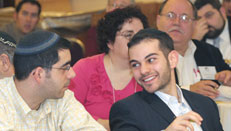 |

Three times a year Jews were to travel to Jerusalem to celebrate together the holidays of Pesach, Shavuot and Sukkot. These holidays commemorated the great historical events of the Jewish people, the exodus, the giving of the Torah and G-d's protection of the Jewish people. Additionally, these were seasons of agricultural importance in Israel ; the beginning of the barley harvest, the ripening of the first fruit and the wheat harvest, and the end of the harvest season. While, for the vast majority of the Jewish people who are not directly involved in farming and for the far too many who live outside of Israel, these agricultural holidays may seem archaic, Judaism emphasizes the importance of recognizing the hand of G-d as manifest in nature. Where others may see olam kminhago noheg , events taking their natural course, Judaism sees the hand of G-d. Thus nature and history come together in the spiritual center of the Jewish people. The Exodus and the growing of the crops both can only happen because it is the will of G-d.
For the farmer arriving in Jerusalem it was not enough just to bring the fruit to the temple. Rather he had to give a synopsis of Jewish history; Yaakov, slavery, the exodus, our arrival in the land of Israel . Nature and history are once again intertwined. It is the Jewish people coming together to publicly thank G-d for His role in history and nature that is the essence of Yom Tov. While Shabbat acknowledges G-d as the Creator, Yom Tov celebrates the unity of the people with thousands gathering in Jerusalem to rejoice together. The Mishna describes in great detail the pageantry of the bringing of the Bikkurim, first fruit, to Jerusalem a "mitzvah ceremony" that began each year on Shavuot. The workers would pause from their work to greet those who brought their fruit to Jerusalem . This despite the fact that a paid employee was not even allowed (in Talmudic times) time off for the full davening and was not allowed to greet a passerby while at work. Everybody, however, must participate as the nation acknowledges G-d's blessings.
The bringing of the Bikkurim is meant to bring happiness; "And you shall rejoice with all the good which G-d your G-d has granted you and your family, you and the Levi, the proselyte who is in thy midst" (Devarim 26:11). It is the multitude of Jews coming together and coming together in Jerusalem that brings honour to G-d Himself and joy to His people.
The pageantry of the Temple days is no longer and the thanksgiving offering must await. However, Jews coming together in a mikraei kodesh , a holy convocation to give thanks to G-d must remain our focus on Yom Tov. In fact this is the only way to prepare to receive the Torah. "And Israel camped opposite the mountain"(Shmot 19:2). Our Sages commenting on the Hebrew singular of the phrase vayichan, they camped, comment that they were like one person with one heart, as they collectively understood that only by working together could they hope to successfully implement the teachings of the Torah.
The Sate of Israel and by extension the Jewish people are facing the gravest of questions. There is much debate about the nature (and borders) of the state. However, we must do our utmost in ensuring that the debates to not tear us apart. The Torah tells us that at Sinai there was "thunder and lightning, with a heavy cloud on the mountain and an extremely loud blast. The people in the camp trembled" (Shmot 19:16). This was followed by the most glorious chapter in all of human history. We must tremble at the thought of destructive disunity. If we can succeed in once again being lev echad , one heart, then the current clouds, the loud blasts and trembling will also be followed by the glory of G-d resting upon all mankind. Chag Sameach.
|
 |








